“For the past four years, I’ve been living in the epicenter of some of the best trout fishing in ‘Middle Earth’—as I like to call it—here in Central Washington. Name the species, we have it. Browns, brookies, mackinaw, tigers, Lahontan and westslope cutts, rainbows both wild and hatchery. From fourteen inches to fourteen pounds. A hundred quality lakes, perhaps far more. If you can’t find excellent trout fishing here, you are just not looking that hard.”
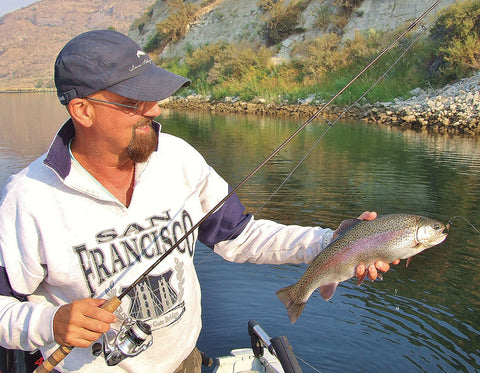
An average central Washington rainbow. It took a 1/4-ounce black/olive twitched jig.
It’s mid March, early in the season for trout fishing. Ice off was only a week ago, tops. Long time STS writer and professional bacon enthusiast Dave Vedder and I are on a modest-sized lake near Chelan on the serious hunt for modest to large brown trout. The browns in this lake can be caught on nearly any lure or bait from April through September. Now, however, they are living in very cold water and have become difficult to catch.
We are not alone, a father and three sons are close by, throwing nickel Kastmasters, after market trout spinners and plunking marshmallows/worms. They have hooked one trout in the two hours Dave and I were there.
We hooked dozens, twitching small jigs on ultralight gear. The staging trout wanted nothing else in the tackle box but a twitched jig. Even though we weren’t exactly quiet having double after double hook-ups, those folks just looked at us like we were stomping on ducklings. Not a single question about what we were doing. It was just another episode of Bill & Dave twitch jigs while others go nearly fishless. After this scene was repeated lake after lake all around eastern Washington for several seasons, it occurred to us that maybe, just maybe that twitching small, natural jigs are the most effective all around trout lure.

For the past four years, I’ve been living in the epicenter of some of the best trout fishing in “Middle Earth”—as I like to call it—here in Central Washington. Name the species, we have it. Browns, brookies, mackinaw, tigers, Lahontan and westslope cutts, rainbows both wild and hatchery. From fourteen inches to fourteen pounds. A hundred quality lakes, perhaps far more. If you can’t find excellent trout fishing here, you are just not looking that hard.
Well, I made it a point to look, and look with a single determined focus. Did my research, I did, all about my local (and not so local) trout lakes. Now, of course I trout fished quite a bit here and there in my five decades, but really never got too deep into it due to this one creature that took up virtually all my time and money…the steelhead.
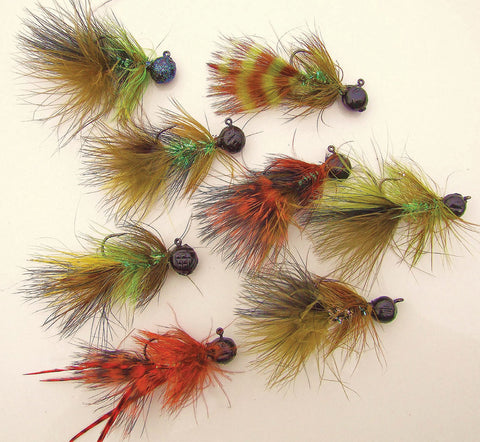
A selection from the author’s jig box. Marabou is the main component for trout jigging success.
I did what anyone should do when learning new fisheries, read all I can, applying that knowledge on the water and most importantly actually going to those places multiple times, fishing under variable conditions and keeping detailed notes. What I found out was steelhead are far easier to find and catch than their land-locked brethren.
I know what you may be thinking, “Just put on some orange Power Bait, toss it out there, open a beer and a lounge chair and reel ‘em in.” Well, there may be a ring of truth to that when trout fishing. But there are many times, when even the “ugly early” baits won’t get bit. Days when the finest tied imitations perfectly presented with the most skillful fly casts are ignored. Lures of every make, color, style, speed…nope. Anything short of live bait (which is ultra-illegal in 99% of lakes) gets zero results. Chalk it up to barometric pressure, temperature changes, approaching spawning, the excuse list is long. They want something that appeals to all their “reactive” senses—predatory movement, something that closely mimics their natural food and just triggers plain aggression.
The one lure, from personal trial and error and from all the research I could glean from other anglers, writers and of course You Tube, is the jig.

What is the jig trying to mimic? Could be injured or frightened bait fish, sculpin darting, startled crayfish, big underwater creepy crawly, we don’t know. Perhaps, like every trout that encounters natural feed initially, this is the first time it has seen anything like it, but feeding instincts take over. There is just something about an erratic, falling lure. Salmon fishermen know this well. Trout follow suit.
Jigs will take trout under all phases of feeding in lakes. During the deep freeze and lethargy of winter through the ice, from ice out when they will gobble a poorly presented tennis shoe to prime days of active packing on weight to near feeding shutdown of pre-spawn. Tough to make that claim about any other lure. Even when worms, single eggs or dough baits won’t get a second look, jigs can take fish.
ABOUT TROUT JIGS
What information is out there for tossing jigs for trout is all over the map, from microscopic 1/64th ounce up to 1 ounce depth charges. Not only lakes, but rivers also, all over the planet where trout live in flowing water, you’ll find the jig. The information you will read here is all about twitching the jig in lake situations. These are from six seasons of findings and suggestions for jig weight, colors, dressing, hook styles and sizes. First about the jigs, then we’ll get into some how to.
First is castability. The jig has to have the right amount of weight. It has to have enough weight to reach target water (distance), get down to the fish without a half hour wait or so much weight it sinks too fast. We need the “goldilocks” weight—just right. Our jig must sink at an enticing rate, fast enough to impart action to the jig materials, to appear to trout it has achieved escape velocity and has to stay down in the strike zone.
Keeping it simple for weight, color and style is gospel when twitching for trout. After doing research (reading all I could find) and taking journal notes for six years, two weights have worked best. Eight species of trout in 100 plus lakes, March through November. One-eighths and ¼ ounce will be your “working tools” in 90% of all conditions and situations. These weights are easily cast, sink at ideal rates and seem to fit into the attraction threshold- small enough to attract, but not too large to possibly repel.

If you cannot find the right weight and hook size in commercially available blank jigs, here’s how to make them:
- #1 90 degree Gamakatsu jig hook
- 1/8th and ¼ ounce split shot
- Super glue
- Big ol’ pair of pliers.
Place one drop of super glue in the “jaws” of the split shot. Place the very end (1/8th of an inch) of the 90 degree bend in the split shot, then with pliers pinch solid on the bend. Allow glue to dry, then paint.
Using just two weights allows you to become familiar with how far they can be cast, how fast each sinks, what retrieve speed for maximum imparted action and how close each stays to ideal depths. A great rule to follow is try the 1/8th ounce for shallow presentations (up to 15’) and shorter casts, and ¼ ounce for deeper twitching or longer casts. It’s similar to a river anglers using 2/5th ounce spoons, ½ ounce #5 spinners or a fly swinger with 10 feet of T-10 in all situations. They know closely how each casts, how quick each sinks and how to adjust for depth. More on that a bit later.
Are there times for smaller jigs, like 1/32 and such? Yes, but those are best presented with a fly rod. Jigs that light are difficult to cast with spinning gear. Whenever trout get size-picky, and they are fairly shallow (3 to 12 feet) where you may target them with a full floating line, 10-foot tapered leader and micro jig, do it. But that’s a topic for another article…
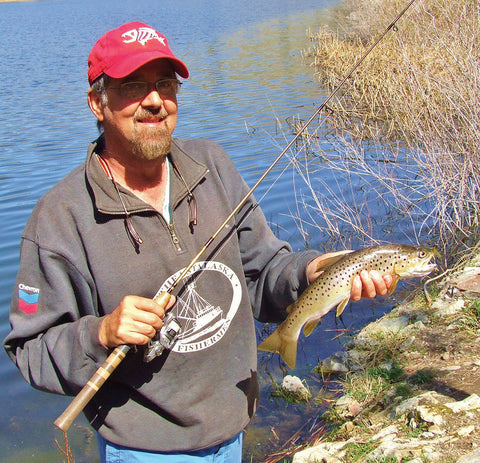
A modest brown from a Chelan area lake. When browns get close to fall spawn they will only take a jig.
Hook sizes, styles? You need a hook that is not too large for smaller trout, yet large enough for the “ones you want.” Hooks should be thin for easy hooksets, yet stout enough for the inevitable fish of the season. Through trial and error, an ideal size and style is the #1 Gamakatsu 90 degree round bend. They are labeled “heavy wire” but trust me they are not thick, feature a thin, strong profile and are sharp out of the package. Hard to find a better choice for trout jigs.
COLORS AND MATERIALS FOR TROUT TWITCHING JIGS
Since the idea behind jig twitching is natural movement, suggesting life, we need to build our jigs with materials that closely mimic life. Undulations, gills, fins, tails, it all needs to move in a life-like manner. This means we tie our trout jigs with materials that “breathe”—marabou, rabbit and webby hackles.
Start with the tail of the jig. Consensus on tail material is going to be more than a 90% vote for marabou. Marabou is the finest material, it resembles undulating, swimming motions. The trick is not use too little, nor too much. An inch to 1-1/2” of marabou tail is perfect. Use only the tips of the feather, take out the quill. Tied to the initial curve in the hook will create a nice profile. Second choice is rabbit strip. Rabbit is more durable, and undulates nearly as well. Use no more than a 1” long piece for the tail, tied on the top of the bend on the very tip of the skin strip.
For the body, tie in the tip of a hackle feather and a working length of fine chenille from the spot the marabou tail is attached to the head. Wrap the chenille first to the base of the head, tie off, then wrap (palmer) the hackle (3 or 4 wraps-leave space between wraps) up to the jig head and tie off. Your finished jig will be 2 to 3”, most will be right at 2-1/2” long, from tip of tail to head.
For colors, all throughout the seasons and in so many lakes all over the North-west, journal notes show definite colors and color combinations that truly stand out. These colors, however, do not vary much.
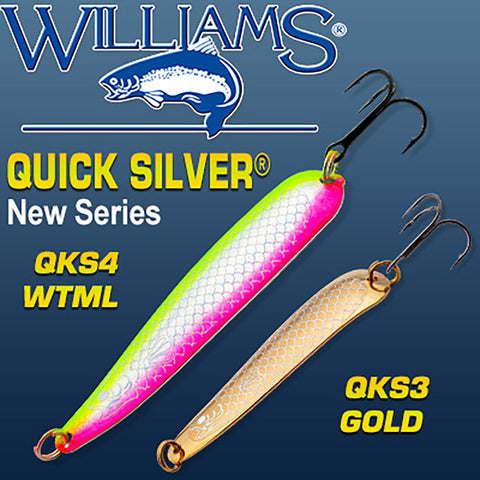
Start with the jig head. For 95% of all trout jigs I use, and have seen, paint them black. Black works in every condition, and always seems to create aggression in all species of trout. All glow for a few others, for extreme depth, very early or late in the day under fading light. Black just flat works better than everything else.
When choosing colors, always try to use at least one other color. Contrasting to multiple colors have consistently gotten bit far more than mono colors for trout. And do not fall into the trap of the beginner tyer by using too much material. Less is more. Thin profiles work far better than “fat” jigs. Thinner profiles “breathe” better, imparting far more action, cast and sink better, plus they look natural.
There are several color combinations that are my go to jigs on a new lake, just the colors I have a load of confidence in and have done very well using them. My favorite color combo for trout jigs is this:
- Equal strands of olive (dark and/or light), black and dull yellow marabou for tail
- Sparkle fine olive chenille for body
- Grizzly (barred) large chartreuse/black hackle wrapped on body
- Black head
Most of my trout jig twitching is something very close to this recipe. Like I do when tying steelhead flies, I try to make them similar but each one always turns out slightly different. Olive and black for tails, body and hackle will work well also, and is quicker to tie.

A Montana brook trout from a lake at 9,000 feet. From here to sea level, jigs take trout.
There is a color preference table, so to speak, for each species of trout. Not always, but there have been so many times when one species of trout will really react to certain colors. Coastal and westslope cutthroat, wild and planted rainbow and especially large eastern brook love my “favorite” color blends, but the rare, large Lahontan cutthroat prefer bright colors over naturals. The “fire tiger” colors (orange, Kelly green, black and bright yellow) and pure white/black head are consistent Lahontan killers.
Pure white/black heads seem to be the choice of triploid rainbows, the ones that live in Rufus Woods in particular. Yellow and brown tail bodies/black heads are the only choice for brown trout, especially in the fall when they approach spawning time.
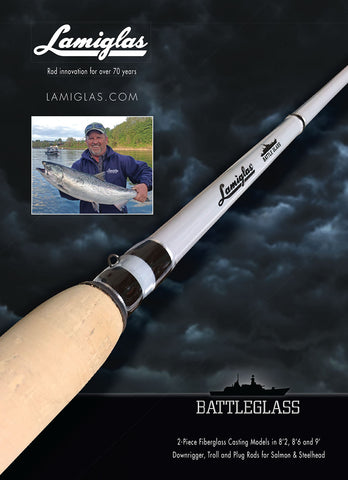
If you stick with these colors, for these species, wherever and whenever you find them, bets are your success rate will be more than decent.
Always keep a few “novel alternative” color(s) in your jig box. If you work an area thoroughly, and you feel (or see) there are more fish to be had, change. They may have “staled” toward you colors, been stung or just no interest. If you are likely using color blends, try a solid color, either all black (including the head), all white (white head) or all purple (black head). What about materials like rubber legs, Crystal Flash, Flashabou? Sure, but remember, less is more. Just two or three strands are plenty as far as flash goes. I use crystal chenille for jig bodies (the only flash I use), not using any flash in the tail.
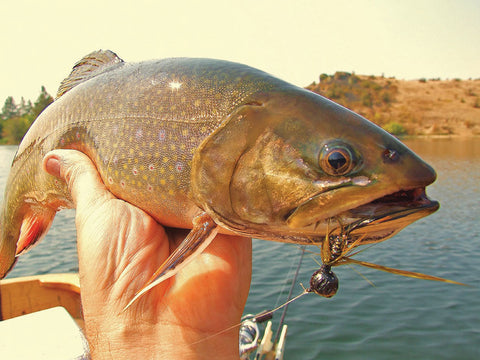
Nineteen inches of eastern brook trout that ate a 1/4-ounce black/olive/dull yellow jig from a Colville Reservation lake.
For those that don’t tie, are there jigs commercially available? You bet, just do a bit of browsing on line or down at the larger outdoor shops, you will find enough assortments, styles and colors to drain a wallet. Just keep natural contrasting colors in mind when shopping.
We looked at colors, styles, weights, hook sizes for jigs. How about a list of rods, reels, lines for presenting the jig?
RODS, REELS, LINES
A fast action/ultralight rod is perfect for trout jigging. For casting, swift action for moving the jig easily and maximizing cast-ing distance with minimal effort, think 7 to 7-1/2 foot. My favorite is the TSR-901-2 G. Loomis two piece, 7’6”, 2-8# spinning rod, or the GL2 841-S TJR 7’0” rated for 2- to 6-pound line. For reel, a 1000 Shimano Stradic or the like is a perfect balance, featuring a far too smooth drag. For mainline, a no stretch fused superline is the only choice. These lines let you set a hook at the furthest distance and allow supreme feel for the lightest bites. Try 8# white Nanofil or 10# white Power Pro. Tape it to the spool to prevent slippage. These lines have the diameter of 4-pound mono, have greater line capacity, cast further than mono, transfer power on hooksets without stretch, do not twist like mono and the soft white color is easily seen throughout a presentation. Uni-knot 6 feet of 8# clear mono or fluorocarbon for a “top shot” that trout cannot see, an easy leader for tying to the jig and a stretch bumper for savage strikes. Try this setup and I promise you will never use straight mono again. So now you have the gear. How do I do it?
THE TECHNIQUE…TWITCHING THE JIG
When you get to the lake, to work most efficiently, first have some idea of depth trout may be found. Having recently fished, knowing other anglers who have recently fished or looking back on journal notes help. When in doubt, start shallow and work out to greater depth gradually until you get bit. Knowing where they are holding/feeding eliminates a lot of blind casting and wasted time. Just like steelheading, positioning is paramount to success.

My preference, like the other killer pimp trout jig twitchers I’ve stolen all my knowledge from, like to stand on shore or position (anchor) their boat in the shallows, say 5 to 10 feet of water. From this spot, you may fan cast, beginning straight out into deepest water then progressively casting shallower side to side.

Author holds a perfect rainbow from one of the many jig friendly lakes near Twisp.
Work your jig from deeper to shallower water, back to your position if possible. The act of retrieving line, rod angle and line resistance drawing through the water will make your lure rise during retrieve. A bottom that tapers upward toward your position will keep the jig in the “loaded” water longest. This is of course a generalization, as some lakes are even depth or vary in depth from your position. Now that you are properly positioned, here’s how it’s done…
Make your cast, allow your jig to sink on a slack line, but not totally slack. Watch your mainline as it sinks (a visible line really helps here), perhaps give it a slight twitch a few times if it’s entering deeper water. There will be suspended trout that will grab the jig on its initial drop. The instant the jig touches bottom, or immediately before on a calculated guess, start your presentation. When jig twitching, most of your strike swill come near the bottom, just above rocks or weeds. That is where the food is at, so find the restaurant, find the patrons.
Know that less is more when it comes to jig movement. Since we are using a fast-action, ultralight rod (paired with a no stretch mainline), a short movement of the rod tip will impart more than enough action to the jig. Big sweeping movements up and down will spook more trout than attract. It may vary slightly, but a standard retrieve/movement is two medium speed revolutions (one thousand one, one thousand two) of the reel handle while simultaneously imparting a six to eight inch movement of the rod tip.
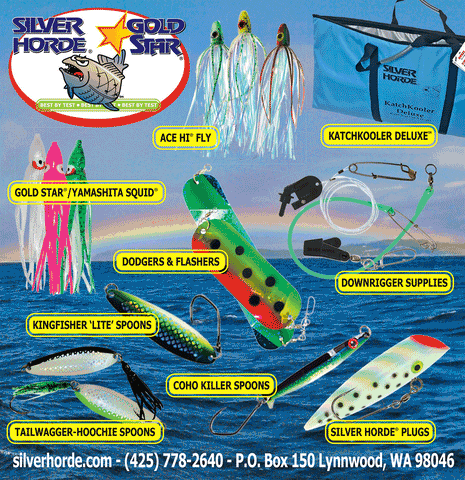
My favorite, all around “cadence” is one reel, twitch, let drop for one second, twitch-twitch, drop for one second, one reel, twitch, drop, repeat until retrieved. Try to stay as close as possible to the bot-tom during the entire retrieve, easier with a ¼ ounce jig than a 1/8th. When using the 1/8th ounce give it an extra second on the drop to reach proper depth.
Small movements are all you will ever need, especially early season or very late when trout are more lethargic in colder water. The design of this jig is to look alive. The marabou tail undulates with the slightest movement, actually more action when moved in inches rather than feet. The twitching rhythm/cadence possibly mimics a scooting crayfish, perhaps a wounded baitfish/sculpin…we think. Just know it works!

The rare and very photogenic tiger trout from a Wenatchee Heights reservoir. A 1/8th-ounce black olive jig was irresistible.
Several times a year you may find yourself on anchor in the deepest water, directly above where trout are holding. Twitching for trout works best when fish are found in 30 feet of water or less. Anchoring makes deeper water jigging easier, especially if there is a wind. Simply dropping the jig to the deck, reeling up a few feet and working it like you are ice fishing does work, but I’ve noticed you may get more bites if the jig is covering ground, so to speak, in “escape mode.” Casting out and working the jig back to your position covers more water and seems to make trout increasingly aggressive to the jig. Get out to the lake and practice!
MORE JIG TIPS…LITERALLY
Jigs alone are effective, no doubt. As we all know, trout can be picky even toward our finest presentations. Tipping the jig with a tasty morsel can sometimes produce the only bites of the day, also turn a bite back on for pressured trout.
My favorite, most effective and most durable is a single natural white Gulp maggot. These tough little baits are easiest to store, just keep a jar with you. Hang one on the bend of the hook, just enough on the tip of the maggot so it hangs straight. They can take fast rod whips on long casts, and often stay put after a missed strike. A small, ¼” bit of nightcrawler works just as well, but the artificial Gulp has nearly unlimited shelf life and is 3 times more durable.

The new Rooster Tail scent spray by Yakima Bait is a have-to-have in my trout jig box. It “flavors” the body and tail without matting down the marabou and hackle. Oils and paste scents work poorly with jigs, matting down materials and retarding all action.
Are there more colors? You bet. These are just colors that have worked very well for me and others. You know how hard it is to put down a successful combo you have confidence in and experiment. But as the saying goes, what isn’t tried, won’t work. Your next experiment may be the killer combo that works better than anything previous. These colors and materials here are just a starting point, suggestions.
Fly guys will tell you they caught their trout on “indicators and balanced leeches.” It’s a jig, man. Like a BC Steel is a “curved weighted fly made from nonanimal parts.” If it’s tied on a 90 degree jig hook, heavily weighted near the eye, various fur and feathers adorning…it’s a jig. A fly rod and bob…er, indicator is just another way of presenting the jig.

Ten pounds of Rufus Woods triploid rainbow. Triploids are suckers for white or olive jigs.
The only drawback with twitching jigs for trout is you will miss a lot of strikes, primarily due to 80% of grabs happen while the jig is on the drop. Bites can be rod-creaking to the cork hookset optional slams, but most of the time it’s no more than a sharp “tick.” Even the fastest gun in the West will miss a rapid mouthing and immediate drop.

I’m in my custom 12-foot wooden pram on a Colville Reservation small lake in late October. The freeze is only a week or so away. The trophy brook trout this lake is famous for are staging in the shallows, pre spawn. Schools of 16- to 23-inch technicolor char are moving with a purpose around me. They do not want the chronomids on my fly gear they attacked so greedily two weeks ago. They do not want a slowly sinking nightcrawler. Or spoon or spinner. What they are striking, after trial and error, almost every cast is a black head/olive/black/dull yellow ¼-ounce jig.
Yes, there will definitely be times when trout are shut off—completely shut off. Extreme conditions will do that to any salmonid. But I can say, without a bit of hesitation, that under the majority of conditions, be it time of year, clarity, lighting, temperature, species, high lake, lowland lake, no matter—a jig will get results.
Did you enjoy this article? If so, please subscribe today to Salmon Trout Steelheader magazine and support STS and this website!








